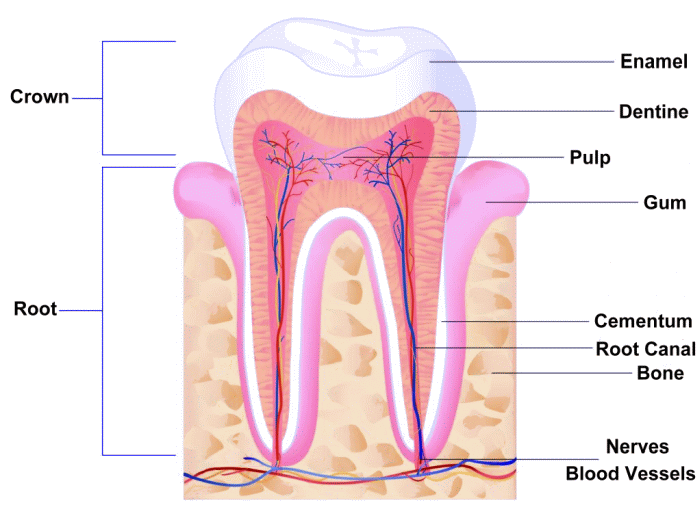
 What’s inside a tooth? As you'll see in the diagram below, there are two main parts to a tooth: the part you can see, which is called the crown, and the part below the gum line, which is called the root.
The crown is protected by a covering of enamel, while the root is covered with cementum. If your teeth are healthy, the roots are entirely embedded in the gums and bone. However, poor dental health can cause the gums to recede; this can led to periodontal disease.
What’s inside a tooth? As you'll see in the diagram below, there are two main parts to a tooth: the part you can see, which is called the crown, and the part below the gum line, which is called the root.
The crown is protected by a covering of enamel, while the root is covered with cementum. If your teeth are healthy, the roots are entirely embedded in the gums and bone. However, poor dental health can cause the gums to recede; this can led to periodontal disease.

Enamel
Enamel is the hard material that covers and protects the crown of the tooth. Enamel contains no living cells so it can't repair itself if it decays.
|
|
Cementum
Cementum is the hard material that covers the roots. It attaches the tooth to the jaw bone. In a healthy mouth, the cementum is not visible.
|
Dentine
This is located just beneath the enamel and cementum. If you lose enamel through decay or wear, the dentine's tubules will allow various stimuli like hot or cold temperatures or acidic foods to stimulate the nerves and cells inside the tooth, which can cause sensitivity and pain.
|
|
Pulp Chamber
At the center of each tooth is a soft tissue called pulp. It contains nerves, blood vessels, and connective tissue. During growth and development, the pulp nourishes the tooth; after that, a tooth can survive without the pulp, which can be removed during a root canal.
|
Root Canal
The portions of the pulp chamber that are inside the roots are known as root canals. They contain pulp, nerves, and blood vessels. If an infection reaches this portion of the tooth, it will be painful and require immediate treatment. The term 'root canal' is used to describe a root canal treatment.
|
|
Nerves and Blood Vessels
These may be inflamed due to deep decay or damage, when bacteria and toxins invade the pulp, causing a toothache. The solution is usually a root canal treatment: removing the nerves and blood vessels and the refilling the space with a rubbery material known as gutta percha.
|
Resources
HTML & design by Bill Willis 2023
|





